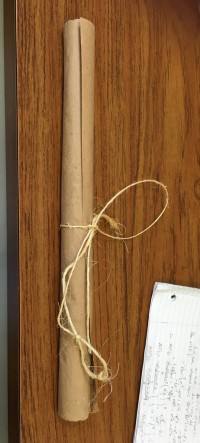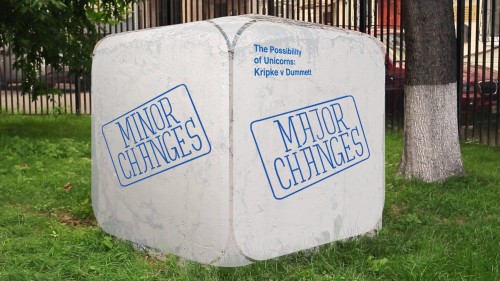By Michael Banks
From a physicist playing at this year’s Masters golf tournament to an animal halting CERN’s Large Hadron Collider (LHC), physics has had its fair share of bizarre stories this year. Here is our pick of the 10 best, not in any particular order.
Dinner that’s out of this world

This culinary concoction was created by food artist Pridence Staite. (Courtesy: Ash Photography)
Before setting off to the International Space station (ISS) for six months late last year, UK astronaut Tim Peake revealed that one of the meals he would miss most was the classic British roast dinner. So what better way to celebrate his safe return to Earth in June than to create a portrait of him made from his favourite nosh? Designed by UK “food artist” Prudence Staite for the Hungry Horse pub chain, the culinary concoction took 20 hours to make and contained 5 kg of roast potatoes, 3 kg of cauliflower, 2.5 kg of meat, 0.5 kg of carrots, 0.4 kg of garden peas, a whopping 46 Yorkshire puddings and one litre of gravy. The finished portrait weighed in at 12 kg and says “Welcome Home Tim”. Hungry Horse has even offered Tim and his family free roast dinners for life.
Pop goes the LHC marten
You may remember the strange story in 2009 when a bird apparently dropped a piece of baguette onto CERN’s LHC. The bread caused a short circuit in the collider’s cryogenic equipment, which heated one of the eight sectors in the LHC’s 27 km long ring and forced the facility to temporarily close. So when the LHC unexpectedly lost power in April we wondered what could the culprit be this time? The answer: a marten. The little weasel-like creature apparently got inside an electrical outbuilding and gnawed through a 66 kV transformer, which ended up frying the creature and causing a wide power outage. After engineers removed the charred remains, the fault was easily repaired and it only took a few days for the LHC to restart. “We’re in the countryside, you have wild animals,” noted Arnaud Marsollier, CERN’s head of press, leaving one wondering what could be next to halt the LHC.
Nuclear poo
A rouge marten wasn’t the only case of an animal putting a stop to a facility’s operation. A gloop of bird excrement was responsible for shutting down the Indian Point nuclear power plant in the US according to a report published in March by Entergy – the firm that runs the plant that lies around 50 km north of New York. The power station automatically shut down when a string of bird droppings fell into some of the plant’s electrical equipment. “Damage was caused by a bird streamer. Streamers are long streams of excrement from large birds that are often expelled as a bird takes off from a perch,” officials noted in the report. “If a streamer contacts an energized conductor, the electrical current may travel through the streamer back to the bird or pole/transmission tower.” In this case, no bird carcasses were found nearby. The firm will now install bird guards to prevent any future streamer incidents.
A well lit shadow

Well Lit Shadow. (Courtesy: Jake Hertzog)
Fancy adding a suite of solo electric-guitar tracks inspired by images from CERN’s Large Hadron Collider to your record collection? Then make sure you get hold of Well Lit Shadow by the US jazz-rock guitarist Jake Hertzog. For only £7.90 on iTunes, the album contains tracks that apparently depict the chaos and beauty of subatomic-particle collisions. Hertzog’s fascination with physics is influenced by his father David Hertzog, a particle researcher involved in several projects including the proposed Muon g–2 experiment at Fermilab. “I tried to learn what I could about his work growing up and have followed recent developments in particle physics through the news and speaking with him,” Hertzog told physicsworld.com. Indeed, this isn’t the first time that Hertzog has been inspired by science. His previous studio album – a collection of jazz classics – is entitled Beyond the Standard Model. “It’s a very exciting time to be an artist, so many amazing ideas to be inspired by,” Hertzog adds.
Physics at the Masters
This year’s Masters golf tournament at Augusta National featured a physics graduate playing alongside the sport’s elite. With a then world ranking of 349th, US amateur Bryson DeChambeau at the time was a physics graduate of Southern Methodist University in Dallas. DeChambeau, who admits to being a “physics nut”, even applied his physics knowledge to the sport by designing new clubs after discovering it was easier to swing his irons if they were each 95 cm long and had a mass of 277 g. Usually, short clubs such as wedges have a shorter shaft, while longer clubs such as a 1-iron have a longer shaft to help the ball go further. Yet DeChambeau found he was hitting his new clubs the same distances as the old set regardless of the length. “If you can beautifully mesh the art and science sides to enhance your game, there are no downsides,” he noted. Alas, the clubs did not help DeChambeau pick up a green jacket as he only mustered 21st place. Yet he has since turned professional and climbed the world rankings to 121st.
LIGO recap
Still on sport, Australian swimmer Cameron McEvoy caught the attention of onlookers at the Australian Championships in Adelaide this year when the 21 year old donned a rather striking black cap. His headgear featured the gravitational-wave signal that was detected in late 2015 by the Advanced Laser Interferometer Gravitational-wave Observatory in Washington and Louisiana. Sporting scientific data might seem an unusual choice, but McEvoy is currently studying physics and mathematics at Griffith University in Australia. Having bagged the 50, 100 and 200 m freestyle events at the championships, reporters asked McEvoy – nicknamed “The Professor” – about the headgear. “That pulse on my cap is the signal they detected when two supermassive black holes collided and made space–time ripple,” he explained.
Quantum charter

All wrapped up.
When Joseph Kamberos, a student at Loyola University Chicago, began writing his quantum mechanics assignments on extra-long paper to carry out the long derivations, he was met with a swift rebuke. A marker asked the undergraduate to use regular-sized paper instead, adding that he wasn’t “writing the Magna Carta”. The student hit back and for his next assignment “pulled an all-nighter with a few beers” to create a handmade scroll of the Magna Carta, written in Latin and tied with twine, with his quantum-mechanics equations at the bottom. Kamberos received top marks for the work, with the marker adding a note at the bottom saying “Glory and honor onto you.” The department is even thinking about framing the scroll and hanging it up in the physics study room. “Everyone had a good laugh about it,” he told physicsworld.com. “All the teachers loved it.”
A false dawn
AuroraWatch UK – run by a group of researchers at the University of Lancaster – sent out a “red alert” to its e-mail subscribers in August advising them of a huge surge in geomagnetic activity that could point to a big show of the northern lights. The group usually takes measurements from a set of magnetometers dotted around the UK, with the main one located in Aberdeen. But with that sensor out of action at the time, AuroraWatch UK turned to a sensor at the University of Lancaster as its lead. Turns out, the apparent huge spike in activity had nothing to do with space but was actually caused by the operation of a groundskeeper on a sit-on lawnmower who ventured too close to the sensor. “We’ll work with the facilities team to try and avoid an incident such as this occurring in the future,” the team wrote.
The bets are off
We don’t know if CERN will ever have to face up to the “nightmare scenario” of the LHC failing to spot any particles beyond the Standard Model. But the particle no-show is already a reality for some physicists who placed bets on a potential discovery. At a conference in Copenhagen in August, physicist Nima Arkani-Hamed presented a 1000 Danish krone (£110) bottle of cognac to Poul Damgaard, director of the Niels Bohr International Academy. The bet was set up in 2000 and since then 20 physicists, including Arkani-Hamed, signed it claiming that supersymmetry would be experimentally detected within 10 years, while 24 physicists disagreed. Each of the 20 losers of the bet now have to buy a bottle of “good cognac at a price not less than $100” to be shared among the 24 winners. Another to pay out is the Nobel laureate Frank Wilczek, who in 2009 bet physicist Garrett Lisi $1000 that superparticles will be discovered at the LHC by July 2015 (extended a year due to delays at the collider). Lisi told physicsworld.com that the money will go towards funding the Pacific Science Institute – a small science institute for researchers on the Hawaiian island of Maui. Lisi says that he hasn’t received the cash yet. “But I’m not worried – Wilczek is a great guy.”
A monument to peer review

Igor Chirikov’s momument celebrating peer review. (Courtesy: Igor Chirikov)
To celebrate those hard-working people who peer review research papers, Russian sociologist Igor Chirikov from the National Research University Higher School of Economics in Moscow had an inspired idea: to build the world’s first monument to their efforts. He raised $2521 via 123 backers on Kickstarter for a sculptor to turn an “ugly” block of concrete outside the university’s Institute of Education into a die. Not any ordinary numbered die, but one that reads “accept”, “minor changes”, “major changes”, “revise and resubmit” and “reject” on its five visible sides. Chirikov, who is also based at the Center for Studies in Higher Education at the University of California, Berkeley, US, told physicsworld.com that he wanted to acknowledge the role of peer reviewers and use it to “have a good laugh” about the peer-review process. “I hoped that academics would like the idea but was a bit surprised how fast we’ve reached the fundraising goal,” says Chirikov. “It means that there are common challenges in [the] academic profession across the world and disciplines. It also means that scholars have a good sense of humour.”
You can be sure that next year will throw up its fair share of quirky stories from the world of physics. See you in 2017!
Guidelines
Show/hide formatting guidelines
this text was deletedwhere people live in harmony with nature and animals</q>
Some text